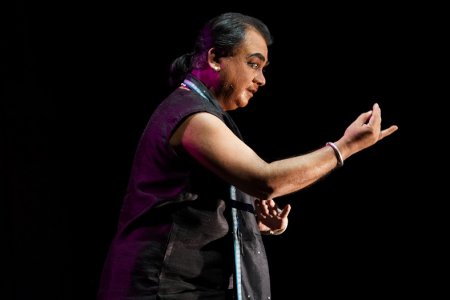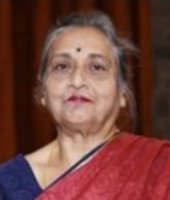
|   |

|   |
Anantya: An evening of Indian classical music and dance - Nita Vidyarthi e-mail: nitavidyarthi@gmail.com Photos courtesy: Srjan March 16, 2020 Two well-known artistes, sitarist Anjan Saha and Odissi dancer Kaberi Sen of the Kolkata based organisation 'Divine Inspiration' presented an inspiring evening of Indian classical music and dance titled 'Anantya....bliss infinity' at the Uttam Manch, Kolkata. The well curated event was not a hurried one, comprising of an Odissi dance presentation by Guru Ratikant Mohapatra and his Srjan Ensemble, vocal recital by Pandit Suman Ghosh with star accompaniment on the tabla by Pt. Swapan Chaudhuri with Hironmoy Mitra on the harmonium, concluding with a sitar-sarod jugalbandi by Pt Mormukut Kedia and Pt Manoj Kedia supported by Raj Deshmukh and Adityanarayan Banerjee on the tabla.   Concentrating only on the dance segment, it being the relevant point of discussion here, an observation of 'Antara Rama', the first of the bouquet of four of Ratikant Mohapatra's choicest choreographed pieces, was proof enough of what exotic performances were to follow in the 80 odd minutes presentation of Srjan. 'Antara Rama' was the episode of 'Hanuman and the pearl necklace' from the Ramayana during the coronation of Rama at Ayodhya. It documented Hanuman's great devotion for Lord Rama who also declared Hanuman to be "Chiranjeevi", to remain in the world as his representative, as Rama ascended to his heavenly abode. The piece opens at Ayoydhya when Rama, during his coronation, in the presence of his family and councils distributed gifts to all those who had helped him. Hanuman expressed his great devotion for the lord and desired nothing. Sita removed a valuable pearl necklace from her neck and offered it to Hanuman which he accepted with great respect. The dancers unfurled the details with a variety of crisp movements. Some remarkably articulate and pleasing were Hanuman breaking open the pearls in the necklace with his teeth to see whether Rama is present or not and the final compelling imagery of tearing open of his chest. At this point Hanuman's "Ram bin sab kuch janat naahi" and the final sashtanga pranam (lying prostrate on the ground) to the lord, blurred the border between the dancers, musicians and the audience, creating altogether an emotional as well as intellectually moving experience. Ratikant's choreographic imagination was like striking fire and the immaculately trained dancers' execution fit into the charged expressions as well as movement patterns. Set to adi taal and raga Jogiya with music composed by the late tabla maestro Nikhil Ghosh, the support music was by Rupak Parida. Kabir's verses spiced up the devotional colour of the melodic strands with subtlety. Orange costumes were in perfect sync with the theme illuminated by gold and a tint of shocking pink. As always with Srjan productions there were no character costumes or props. Witnessing the piece was a heartfelt and spiritually tinted experience. The next piece, a Jayadeva ashtapadi "Raase Harimiha" with Pandit Jasraj's music began with a hypnotic refrain of the flute as the dancers explored the possibilities of the Odissi grammar, crystalline movements, delicate sways, embellished with "pohondi" movement patterns, principally linear geometric ones, documenting their training and ability to work in synchronization and understanding of the creative brilliance of their choreographer Ratikant Mohapatra.  Ratikant Mohapatra Ratikant's ekapatra abhinaya piece "Shabari" has reached new heights with increasing number of performances, with a range of aesthetic hues, exemplification of the right measure of dramatic and choreographic elements from exquisite to the grand with a sublime creative convergence. So it was gratifying to watch this piece adapted from Tulsidas' Ramcharitmanas once more. The concluding piece was a sensational one both in terms of the pulsating music by Dr. Vyzarsu Balasubrahmanyam and the neo-classical innovations by Ratikant Mohapatra using Odissi as a springboard to evolve a contemporary visually spectacular dance vocabulary infused with the spirit of the classical. In this 'Kirwani Madhurima,' Dr. Balasubrahmanyam explored the endless possibilities of Hindustani and Carnatic music, the shining parts being the intermittent pulses and the staccato effects. Classical instruments find their place side by side with the electronic orchestration with mardala taking the lead. The virtuoso mix of music combined wonderfully with the elegant display of torso bends, body inflexions, undiluted quality of the grammar of nritta of the Pallavi and the superb dancing of the highly disciplined, immaculately trained dancers of Srjan. Sanskrit inputs by Pt Nityananda Misra like "Ananda Sadanandam", script and narration by Aditya Mahapatra and light designing by Debiprasad Misra make this already familiar piece a prime choice.  Dr. Nita Vidyarthi is a veteran critic of performing arts and writes on dance, music and theatre in leading publications. |